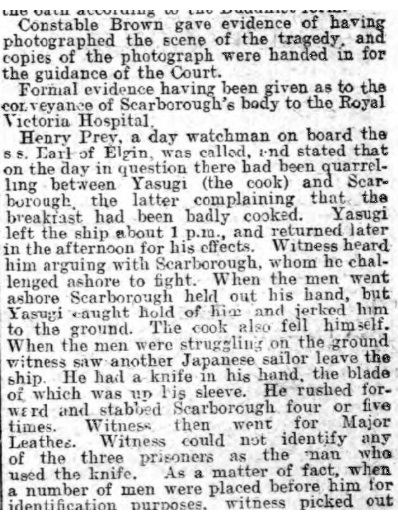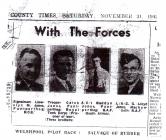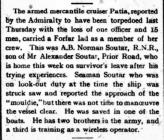Gellir lawrlwytho cynnwys at ddefnydd anfasnachol, megis defnydd personol neu ar gyfer adnoddau addysgol.
Ar gyfer defnydd masnachol cysyllwch yn uniongyrchol gyda deilydd yr hawlfraint os gwelwch yn dda.
Read more about the The Creative Archive Licence.
Disgrifiad
Dyddiad: 14 July 1917.
Adysgrif:
STABBED TO DEATH.
BELFAST DOCK TRAGEDY.
DECEASED AND FAIR “PLAY.”
The grim scene which was enacted on the quayside at the Musgrave Channel on the evening of the 3rd inst., when Robert Scarborough, a fireman on board the s.s. Earl of Elgin, was stabbed to death, was further described before Mr. John Gray, R.M., in the Belfast Custody Court on Tuesday. District Inspector Harrison prosecuted; Mr. T. A. M’Lernon appeared for the defence. Major Leathes, officer commanding at Belfast Docks, was present during the hearing of the case. The prisoners were three Japanese seaman, named Matsuzo Kawaba, Mashani Kurata, and Massataka Yasugi, and they faced the charge of having wilfully murdered Scarborough.
At the outset Mr. Naogi Mayeda, a Japanese shipping agent, who had travelled specially from London to act as an interpreter in the case, was formally sworn by the clerk, taking the oath according to the Buddhist form. Constable Brown gave evidence of having photographed the scene of the tragedy, and copies of the photograph were handed in for the guidance of the Court.
Formal evidence having been given to the conveyance of Scarborough’s body to the Royal Victoria Hospital.
Henry Prey, a day watchman on board the s s. Earl of Elgin, was called, and stated that on the day in question there had been quarrelling between Yasugi (the cook) and Scarborough, the latter complaining that the breakfast had been badly cooked. Yasugi left the ship about 1 p.m., and returned later in the afternoon for his effects. Witness heard him arguing with Scarborough, whom he challenged ashore to fight. When the men went ashore Scarborough held out his hand, but Yasugi caught hold of him and jerked him to the ground. The cook fell himself. When the men were struggling on the ground witness saw another Japanese sailor leave the ship. He had a knife in his hand, the blade of which was up his sleeve. He rushed forward and stabbed Scarborough four or five times. Witness then went for Major Leathes. Witness could not identify any of the three prisoners as the man who used the knife. As a matter of fact, when a number of men were placed before him for identification purposes, witness picked out another man altogether.
ASKED A FAIR FIGHT.
To the District Inspector— -Before the scuffle witness heard Scarborough say something about "a fair fight.” William Millar, a ship’s plumber, who lives in Tennent Street, also gave evidence of seeing Yasugi and Scarborough go ashore to fight. Scarborough asked the other if it was going to be a fair fight, and he also asked those standing about to see that he got fair play. When Yasugi had twisted Scarborough down, witness saw Kawaba come from amongst the crowd and stab Scarborough not less than four times. After this witness saw Kurata punching Scarborough, but could not say whether or not his blows got home. It all happened within five minutes after the men left the ship.
Dr. S Geddes, Royal Victoria Hospital, stated that when he examined the body of Scarborough, on the evening of the 3rd inst. he found four wounds in the back. Each wound was about an inch and a quarter in length. Witness was present on the following day when Professor Symmers conducted a post mortem examination. It was found that one of the wounds had penetrated the lung and ruptured a large blood vessel near the heart. This proved to be the wound that caused death. When the body was brought to the hospital blood was pouring from the mouth and nose. Death, which was from haemorrhage, must have been instantaneous. Replying further to the District-Inspector, Dr. Geddes said the wounds must have been caused by a very sharp instrument, which had been driven home with considerable force.
While the doctor was giving evidence the Resident Magistrate drew attention to the fact that two men and two women, who occupied the front seat in the gallery, had been conducting an animated conversation, punctuated occasionally with suppressed laughter. That was not a matter for laughter, and if the parties he referred to were only in court through curiosity they had better leave.
The offending spectators were then conducted out of court by a policeman.
A number of other witnesses having been examined, the accused were returned for trial at the forthcoming Assizes.
Ffynhonnell: "STABBED TO DEATH. BELFAST DOCK TRAGEDY. DECEASED AND FAIR “PLAY.”" Larne Times. 14 July. 1917. 1.












Oes gennych chi wybodaeth ychwanegol am yr eitem hon? Gadewch sylwad isod
Sylwadau (0)
Rhaid mewngofnodi i bostio sylw